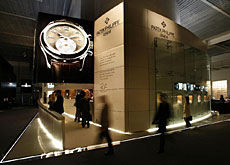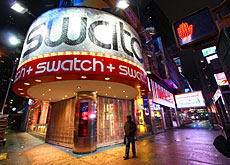Basel shows off luxury to the world

The Baselworld watch and jewellery fair has opened its doors with high hopes that 2006 will prove another bumper year for the luxury goods sector.
The Swiss watch industry will be particularly keen to put in another record performance after posting exports totalling more than SFr12 billion ($9.16 billion) in 2005.
But there was also a warning on the sidelines of this year’s glamorous Baselworld event that the sparkle of gemstones comes at a high human price in the developing world.
If analysts are to be believed, high demand in the luxury goods sector is set to continue in a world economy that has been steadily growing.
While Swiss exports are being driven by the top end of the market, the president of the exhibitors committee, Jacques Duchêne, warned that there had been difficult challenges in the medium-price sector.
“The majority of our exports fall within the upper price range… but it would be unfortunate if, at the same time, development of the products in the mid- range sectors forfeited sales.
Damaging
“This could have a damaging effect in the medium- and long-term on our industry as a whole,” he commented.
Duchêne also was at pains to highlight what he called the “exasperating problem” of imitation goods, with estimations that there are currently 40 million fake Swiss watches sold annually around the world with a value to the imitation industry of SFr800 million.
Other industries were also being affected by the copy merchants, including pharmaceutical products, clothes, toys and multimedia products.
Duchêne said imitation goods had become part of a new lifestyle and their quality was improving every year. “We must admit that the era of unprofessional imitations being made in small numbers is now over.”
The internet, with new sales and auction sites of fake goods, was a threat of “great concern”. “If we do not fight mercilessly against this situation then there is a very real danger that our whole economy will suffer in the not-too- distant future,” he argued.
Duchêne was supported by Swiss Economics Minister Joseph Deiss who officially opened the fair by saying that watchmaking would be promoted as it was one of the strongest branches in terms of exports.
“It is therefore obvious that we don’t appreciate when watches are counterfeited. It is even more obvious that we are fully committed to the protection of trademarks and patents within the World Trade Organization negotiations,” he said.
Gemstone industry
In a related development, a group of non-governmental organisations (NGOs) including Solifonds – a solidarity organisation of the Swiss labour movement – used the occasion of the Basel fair to demand better pay and conditions in the gemstone industry.
At a press conference on the sidelines of Baselworld, they said thousands of workers who polish gemstones, mainly in China and India, are dying because their lungs are clogged with silica dust – a disease known as silicosis.
NGOs called on the organisers of the trade fair to ban companies that seriously violated labour rights. They also demanded that Chinese and Indian companies should compensate silicosis victims and their families.
Basel Social Democrat parliamentarian Remo Gysin, a board member of Solifonds, said the issue was all about fair trade.
“Fair trade means looking after workers’ rights, particularly when it comes to health,” he told swissinfo. “It means bringing down contracts at the WTO and at bilateral levels from the abstract to the concrete, and integrating proper social standards.”
swissinfo, Robert Brookes in Basel
This year’s Baselworld features 2,127 exhibitors from the watch and jewellery industry.
There will be 283 Swiss brands in the watchmaking section and 53 Swiss brands in the jewellery section.
As a sign of expansion, the average stand size per exhibitor has increased by 30% from 39 to 52 square metres over the past five years.
This year’s fair runs until April 6.
Baselworld is the world’s largest and most important annual trade show for the watch and jewellery industry.
With a surface area of 160,000 square metres, it is also the largest trade event held in Switzerland.
About 90,000 visitors from more than 100 countries are expected to visit the exhibition, which shows new collections and trends, as well as giving a pointer to how the industry might perform for the year as a whole.

In compliance with the JTI standards
More: SWI swissinfo.ch certified by the Journalism Trust Initiative










You can find an overview of ongoing debates with our journalists here . Please join us!
If you want to start a conversation about a topic raised in this article or want to report factual errors, email us at english@swissinfo.ch.